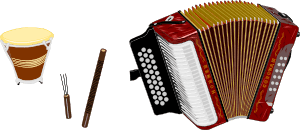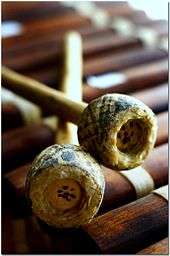Vallenato
| Traditional Vallenato music of the Greater Magdalena region | |||||||||||||||||||||
|---|---|---|---|---|---|---|---|---|---|---|---|---|---|---|---|---|---|---|---|---|---|
| Name as inscribed on the World Heritage List | |||||||||||||||||||||
 Caja, guacharaca, and accordion, the basic instruments in vallenato | |||||||||||||||||||||
| Location | Colombia | ||||||||||||||||||||
| Type | Intangible cultural heritage | ||||||||||||||||||||
| Reference | 01095 | ||||||||||||||||||||
| UNESCO region | Latin America and the Caribbean | ||||||||||||||||||||
| Inscription history | |||||||||||||||||||||
| Inscription | 2015 (39th Session) | ||||||||||||||||||||
| Endangered | since 2015 | ||||||||||||||||||||
| |||||||||||||||||||||
| Culture of Colombia |
 |
|
Art |
Vallenato, along with cumbia, is a popular folk music of Colombia. It primarily comes from the Colombia's Caribbean region. Vallenato literally means "born in the valley". The valley influencing this name is located between the Sierra Nevada de Santa Marta and the Serranía de Perijá in north-east Colombia. The name also applies to the people from the city where this genre originated: Valledupar (from the place named Valle de Upar – "Valley of Upar"). In 2006, Vallenato and cumbia were added as a category in the Latin Grammy Awards. Colombia’s traditional Vallenato music is Intangible Cultural Heritage in Need of Urgent Safeguarding, according to UNESCO. [1]
Origins
This form of music originated from farmers who, keeping a tradition of Spanish minstrels (Juglares in Spanish), mixed also with the West African-inherited tradition of griots (African version of juglar), who used to travel through the region with their cattle in search of pastures or to sell them in cattle fairs. Because they traveled from town to town and the region lacked rapid communications, these farmers served as bearers of news for families living in other towns or villages. Their only form of entertainment during these trips was singing and playing guitars or indigenous gaita flutes, known as kuisis in the Kogi language, and their form of transmitting their news was by singing their messages.
The first form of Vallenato was played with gaita flutes, guacharaca, and caja, and later adopted other instruments like guitars. These troubadors were later influenced by Europe's instruments: piano and accordion. Impressed by the sound of the accordion, troubadors probably later obtained accordions from Aruba and Curaçao. Vallenato was considered music of the lower class and farmers, but gradually started penetrating through every social group during the mid-20th century.
Don Clemente Quintero – a prominent member from the region's elite – was a lover of this music, usually accompanied by liquor, was a form of entertainment for this almost isolated region. He then decided to start a parranda (party) inside the very strict Valledupar Social Club with friends. This triggered an acceptance for the music and it became a regular feature at parties, carnivals and reunions, not for dancing, but for listening to these juglares stories .
Alfonso López Michelsen, a prominent Colombian politician, showed interest in the region as his ancestors and wife were born there. While a Senator, he pushed for the creation of the Department of Cesar and became, in 1966, its first governor. Once in office and together with writer and reporter Consuelo Araújo Noguera and vallenato composer Rafael Escalona, they created the Vallenato Legend Festival.
Instruments

Its three traditional instruments are:
- the caja vallenata: a small drum held between the knees and played with bare hands. It was used by the African slaves brought by the Europeans. Similar to a tambora drum.
- the guacharaca: a wooden, ribbed stick similar to a sugar cane, accompanied by a fork that when rubbed together emits a scraping sound. It's about 18 inches (45 centimetres) long and 1 inch (3 centimetres) in diametre. It was used by the aborigines to imitate the song of the guacharaco, a bird from the region, to hunt and perform dancing rites.
- the accordion: three-line button, German-origin accordion. It has three reeds per note and it comes in different tones, ADG, GCF, BbEbAb "5 Letras". Accordions in Colombia and Panama sometimes have custom made tones especially made for Vallenato and Cumbia
The four rhythms
Vallenato consists of four beats or "airs" that are differentiated through their rhythmic structure and the melody chord structure the accordionist gives it. These are son, paseo, merengue, and puya. The son and the paseo have a 2
4 time and the merengue and the puya a 6
8 time.[2]
- Son is played with heavy accentuation and cadence stressed on the low notes of the accordion on its left-hand side. It's normally mournful and slow.
- Paseo is thought to be an offshoot of the son. Its speed can vary and today is the most widely recorded air.
- Puya's main difference from the merengue is the length of its lyrics. In the last 40 years, accordion players have begun to play it faster, and each of the three instruments used in vallenato has a solo. It is considered the oldest of the four "airs", with roots in an ancient Indian dance of the Sierra Nevada de Santa Marta.
- Merengue is often confused with a Dominican genre with the same name, probably brought by related African tribal groups. It has a more narrative style and was often used to play décimas, a 10-line format with internal rhymes brought by the Spanish in the 16th century.
Piqueria
The piqueria vallenata is a type of typical musical showdown Colombian Caribbean folklore and Vallenato. As in the contrapunteo Joropo burrowing, or trova paisa within the music, litigants demonstrate their improvisational skills in building verses that challenge their opponent. This type of musical confrontation arose as a result of chance encounters between vallenatos minstrels who roamed the northern part of Colombia brightening binges and to demonstrate their talent on the accordion and the art of improvisation faced with songs and rhymes. One of the most important meetings of the Piqueria was between Emiliano Zuleta and Lorenzo Morales, both vallenato accordionists.[3] From this meeting came the popular song La Gota Fría, played in its most popular version by the Colombian singer Carlos Vives.
Vallenato Festivals
The Vallenato Legend Festival: Every year by the end of April, in the city of Valledupar, the Festival de la Leyenda Vallenata (Vallenato Legend Festival) is celebrated. During the festival a contest takes place in which the best vallenato interpreters fight for the title of Rey Vallenato (Vallenato accordion King), "verseadores", new song composers, "guacharaqueros" and "cajeros" are also awarded within three categories; professional, aficionado and infant. The festival also includes record industry's orchestras shows.
Accordions' Cradle Festival: (Festival cuna de accordeones) This festival is celebrated every year since 1979, in Valledupar's neighboring town of Villanueva, in La Guajira. The Festival is similar to the Vallenato Legend Festival format, but also includes a category for the elderly accordion players over sixty years old.
Other Vallenato festivals:
- Nationally: Vallenato Festival in Bogotá;
Vallenato composers, singers and juglares
Thanks to the Vallenato Legend Festival this musical genre became known through the region including regions of Venezuela, and when a popular telenovela, "Escalona", based on the life of Vallenato composer, Rafael Escalona was aired on national television (with vallenato superstar Carlos Vives as Escalona), Vallenato became widely known in Colombia and internationally. Some renowned traditional vallenato performers are Guillermo Buitrago, Alejo Duran, Enrique Díaz, Emiliano Zuleta, Luis Enrique Martínez, Abel Antonio Villa and Lorenzo Morales. Other important characters such as Tobías Enrique Pumarejo and Rafael Escalona never played any instrument, but were important writers of very well known songs across Latin America. Other well-known Colombian musicians who sing vallenatos are Diomedes Díaz, Jorge Oñate, Ivan Villazon, Nicolas "Colacho" Mendoza (accordion player and composer), Juan Humberto "Juancho" Rois (accordion player and composer), Omar Geles (accordion player and composer), Israel Romero, Peter Manjarrés, Silvestre Dangond, Rafael Orozco, Los Gigantes Del Vallenato and Lisandro Meza among others.
The current ambassador of the genre is multiple-time Grammy Award-winner Carlos Vives, who has progressively helped vallenato gain popularity worldwide by combining traditional vallenato music with pop/rock music, subgenre that has come to be known as "vallenato-pop".
Vallenato musical orchestras and groups
The traditional vallenato developed into a more orchestra type of musical group. Throughout the years, some groups started adding instruments and a group chorus to support the main singer, popularly and sarcastically known as "ay omberos". With these changes. Some of the instruments added or used by some orchestras were: the bass guitar, the congas drums, a Timbal set, drum kit, maracas, guache, electric piano, Spanish guitars, tambourine, cowbell, electric guitar, Saxophone, piano accordion, violins, among others. These groups also started fusioning local genres to the vallenato, usually with cumbia, porro sabanero, gaitas (group of gaita flute interpreters), merecumbe and joropo. Some groups seeking a wider audience started mixing vallenato with other international genres, like salsa, merengue, rock, classical music, reggae, reggaeton, ranchera, techno music, house music. Some of these mixes didn't become very popular because of their experimental sounds.
La Nueva Ola (The New Wave)
La Nueva Ola refers to the new generation of Vallenato groups and orchestras that have created a distinctive sound for themselves while keeping some of the essence of their predecessors. Kaleth Morales is considered leading artist of this young wave of vallenato musical groups, even after his death following a car accident on August 24, 2005. The leader is now Silvestre Dangond, who won five awards in Premios Nuestra Tierra in 2009.
Some renowned vallenato orchestras

- Diomedes Díaz
- Los Hermanos Zuleta
- Ivan Villazón
- Beto Zabaleta
- Jorge Oñate
- Alfredo Gutiérrez
- Binomio de Oro de América
- Los Diablitos del Vallenato
- Carlos Vives y la provincia
- Silvestre Dangond & Juancho De la Espriella
- Peter Manjarrés
- Jorge Celedón & Jimmy Zambrano
- Lisandro Meza
- Felipe Peláez
See also
- Music of Colombia
- Vallenato Legend Festival
- UNESCO Intangible Cultural Heritage Lists
- Latin Grammy Award for Best Cumbia/Vallenato Album
- Carlos Vives
- Stelis vallenata a new species of bee from Colombia named after Vallenato
References
- ↑ "13 vallenatos que hay que conocer ahora que el ritmo es patrimonio de la humanidad" (in Spanish). bbc.com. 2015.
- ↑ valleduparnoticias.co – (+fotos) Los ritmos del Vallenato
- ↑ Festival Vallenato http://www.festivalvallenato.com/folclor-v/item/6-piquerias. Missing or empty
|title=(help)
External links
- (Spanish) Vallenato Legend Festival website
